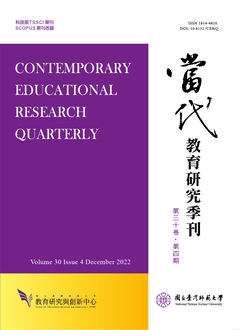

本研究旨在評析Deardorff 跨文化能力模式在東亞儒家文化脈絡中,小學國際交流情境下的應用性。為達成此研究目的,本研究採取半結構式訪談法與文件分析法,先探討Deardorff 之跨文化能力模式,並闡釋其歷程模式對小學國際交流規劃之啟示。在儒家文化脈絡的應用性分析上,本研究分析歸納過去探討儒家溝通能力觀點之論著,從儒家觀點揭示Deardorff 理論模式不足之處,並闡釋儒家觀點與Deardorff 所提出之能力要素相通之處。Deardorff 理論模式在小學國際交流中的應用性則著重於可欲性與可行性的分析,本研究選取3 所具豐富國際交流經驗的學校,訪談其負責交流活動的教育實務工作者,並蒐集4 所小學(含前3 所)國際交流相關文件(含成果報告書、教材、學習單、日記、心得以及活動影片)進行分析。本研究發現,Deardorff 的歷程模式可應用於我國跨國校際交流活動之規劃,而其能力要素具有可欲性,能切合國際交流的需求。然而,東亞儒家文化脈絡所強調之人際關係的維繫與禮節是該能力模式所忽略的,應納入該模式中。同時,特定能力要素的達成受限於小學生之文化背景知識、認知發展以及外語能力,有賴教師有系統地介入與引導,以提昇學生的跨文化能力。
The purpose of this research is to provide a critical analysis of theapplicability of Deardorff’s intercultural competence model to theinternational exchange activities of primary schools within the EastAsian Confucian cultural context. In order to achieve the researchpurpose, semi-structured interview and document analysis areadopted as research methods. The research begins with inquiring intoDeardorff’s intercultural competence model and interpreting itsimplications for planning international exchange activities betweenprimary schools. As for the analysis of the applicability ofDeardorff’s model to Confucian cultural context, the researchanalyses and summarises previous literature on Confucian notions ofcommunication competence. From Confucian viewpoints, thelimitations of Deardorff’s model are revealed and what it has incommon with Confucian viewpoints are interpreted. The analysis ofthe applicability of Deardorff’s model to international exchangeactivities between primary schools focuses on desirability andfeasibility. The research selects three primary schools with richinternational exchange experiences, and conducts interviews withtheir educational practitioners in charge of international exchanges.International-exchange-related documents (including result reports,teaching materials, worksheets, journals, reflective writings, andfilms of activities) from four primary schools (including the threementioned above) are collected and analysed. The research resultsindicate that Deardorff’s process model is applicable to planninginternational exchange activities of Taiwan’s primary schools, and itscompetence components are desirable for the needs of internationalexchange. However, the maintenance of interpersonal relations andmanners emphasised in the East Asian Confucian cultural context areoverlooked and should be included in the model. Furthermore,because the attainment of some competence components isconstrained by primary students’ cultural background knowledge,cognitive development and foreign language ability, teachers’systematic intervention and instruction are necessary to promotestudents’ intercultural competence.

本著作係採用創用 CC 姓名標示-非商業性 3.0 台灣 授權條款授權.
本刊國立台灣師範大學教育研究與創新中心
106台北市和平東路一段162號 | 電話: 02-7749-3670 | E-mail: cerecerq@gmail.com
教創中心 | 師大 | 電子報 | 線上投審系統
本刊由國家科學及技術委員會人文社會科學研究中心補助經費
© 2014 CERI-NTNU
